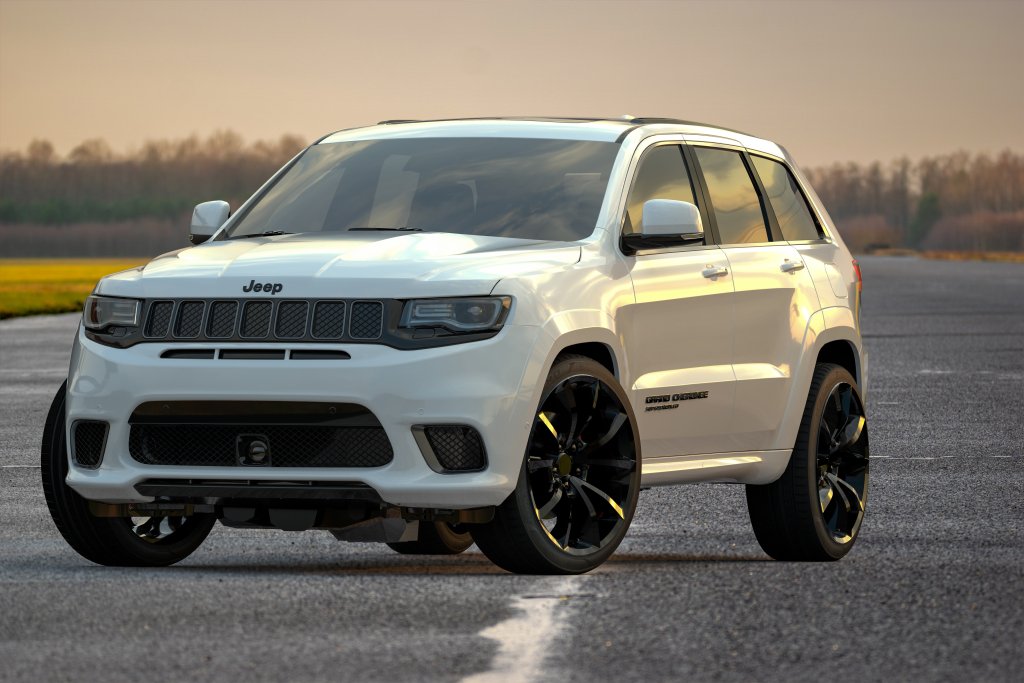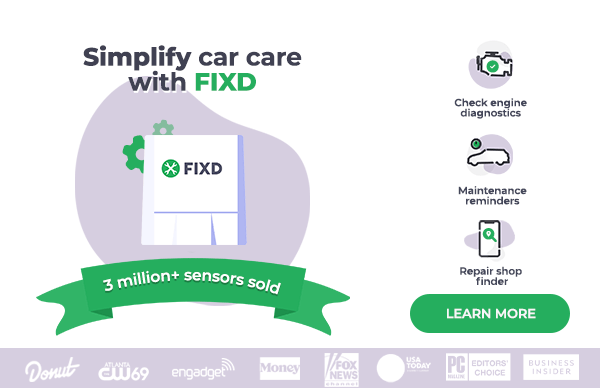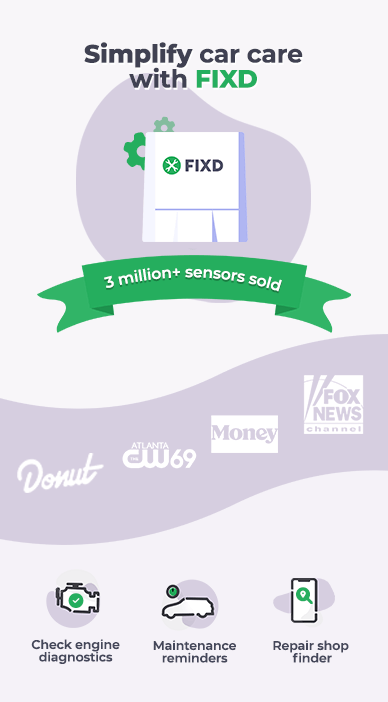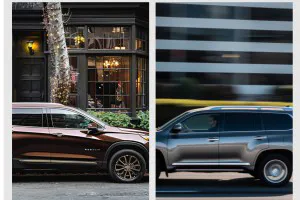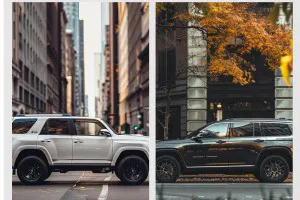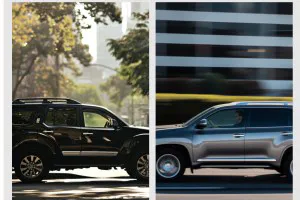Find the depreciation rate of your Jeep Grand Cherokee in the graph below.
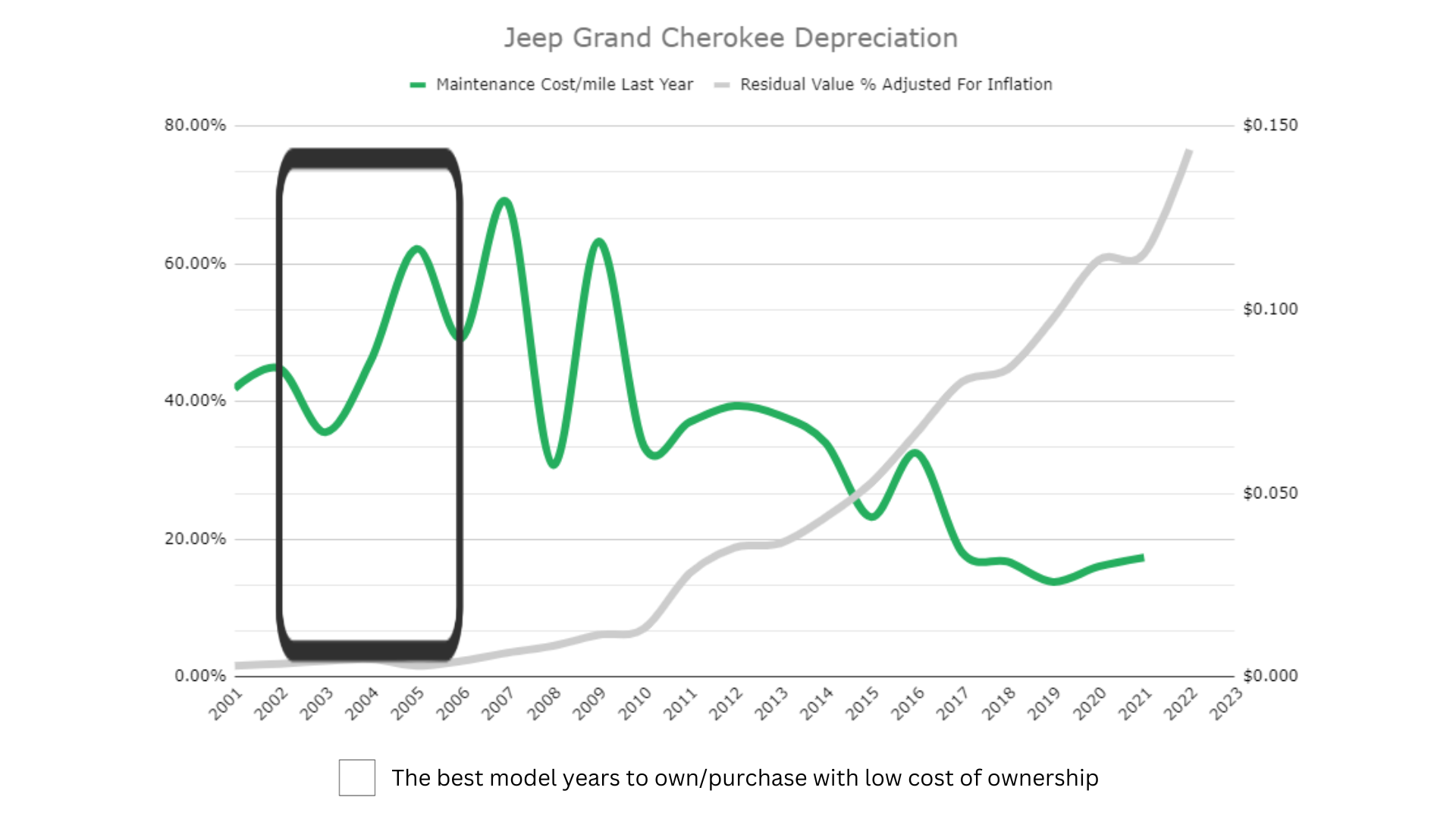
Every vehicle begins to lose value or depreciate from the moment you purchase it. The Jeep Grand Cherokee is no exception. It depreciates most during the first year. After its initial drop in value, the Grand Cherokee will continue to depreciate at a slower rate each year until it reaches the five-year mark. Since all vehicles depreciate at different rates, it’s important to know the depreciation rate of your specific vehicle so you can understand its overall value and cost of ownership.
Keep in mind that just because the vehicle costs the least to own in the sweet spot we have outlined here, you still may not want to own the vehicle during these depreciation sweet spot years. Although vehicles depreciate less as they get older, they have more repairs. Duh right? However, keep in mind that repairs don’t just cost you money, they cost you time. Reliability is the difference between being able to make it to your destination on time or missing an opportunity because the car broke down.
Check out our article on the best and worst years of the Jeep Grand Cherokee to see our reliability ratings for all years of the Grand Cherokee between 2001-2022. We also cover MPG, safety ratings, and a number of other factors. We pulled data from Grand Cherokees registered in our app and surveyed owners to get you data-backed answers on just how good or bad each year of the Grand Cherokee is.
If you want to know the depreciation and maintenance costs for your particular vehicle, use our free “Total Cost of Ownership” tool available in the FIXD App – Android or IOS.
If you like our online tools and articles consider purchasing our FIXD sensor for $19.99 (this is 67% OFF). It’s our flagship product. With it, you scan your car for common engine problems.
If our sensor detects any problems with the engine, our app will clearly explain:
- What could have caused it and
- How much the possible repairs may cost.
If you’d like, we’ll even show you trusted repair shops in your area where you can get your ride fixed through RepairPal. The total cost of ownership feature within the app totals your maintenance costs, repairs, and depreciation (Sensor + App). This is free on the app.
Jeep Grand Cherokee Depreciation
| Model Years | Mileage | Amount Depreciated | Residual Value Percentage | Resale Value |
| 2001 | 264,000 | $33,665.74 | 1.6% | $545 |
| 2002 | 252,000 | $31,808.32 | 1.9% | $628 |
| 2003 | 240,000 | $32,381.37 | 2.3% | $774 |
| 2004 | 228,000 | $34,486.29 | 2.6% | $933 |
| 2005 | 216,000 | $33,200.81 | 1.6% | $541 |
| 2006 | 204,000 | $34,336.17 | 2.3% | $825 |
| 2007 | 192,000 | $34,880.59 | 3.5% | $1,277 |
| 2008 | 180,000 | $36,162.48 | 4.5% | $1,685 |
| 2009 | 168,000 | $37,155.77 | 6.1% | $2,433 |
| 2010 | 156,000 | $36,867.06 | 7.0% | $2,761 |
| 2011 | 144,000 | $32,247.67 | 15.0% | $5,676 |
| 2012 | 132,000 | $27,056.43 | 18.8% | $6,274 |
| 2013 | 120,000 | $27,257.85 | 19.4% | $6,573 |
| 2014 | 108,000 | $26,937.37 | 23.2% | $8,119 |
| 2015 | 96,000 | $26,065.82 | 28.2% | $10,238 |
| 2016 | 84,000 | $23,376.00 | 35.5% | $12,873 |
| 2017 | 72,000 | $20,948.52 | 42.9% | $15,754 |
| 2018 | 60,000 | $20,609.76 | 44.7% | $16,635 |
| 2019 | 48,000 | $18,549.22 | 52.1% | $20,194 |
| 2020 | 36,000 | $15,300.42 | 60.6% | $23,489 |
| 2021 | 24,000 | $15,361.76 | 61.5% | $24,531 |
| 2022 | 12,000 | $9,457.60 | 76.6% | $31,000 |
| 2023 | N/A | N/A | N/A | N/A |
| 2024 | N/A | N/A | N/A | N/A |
The chart above conveys the approximate depreciation for a Jeep Grand Cherokee. It’s based on Kelley Blue Book data since 2001, assuming a vehicle in a standard trim, a generic color such as black or white, and a mileage of 12,000 per year.
Keep in mind that the auto market was heavily affected in 2020 and beyond. Automakers selling new cars during the COVID-19 pandemic raised prices, which caused a spike in demand in the used car market as people tried to save money. Many automakers, however, did not drop prices after the pandemic; they kept them so they could make a larger profit.
This is why the most recent years of many vehicles have seemingly experienced less depreciation. Some, such as 2004, may have even appreciated due to the heightened levels of inflation created.
Factors That Impact the Jeep Grand Cherokee Depreciation Rate
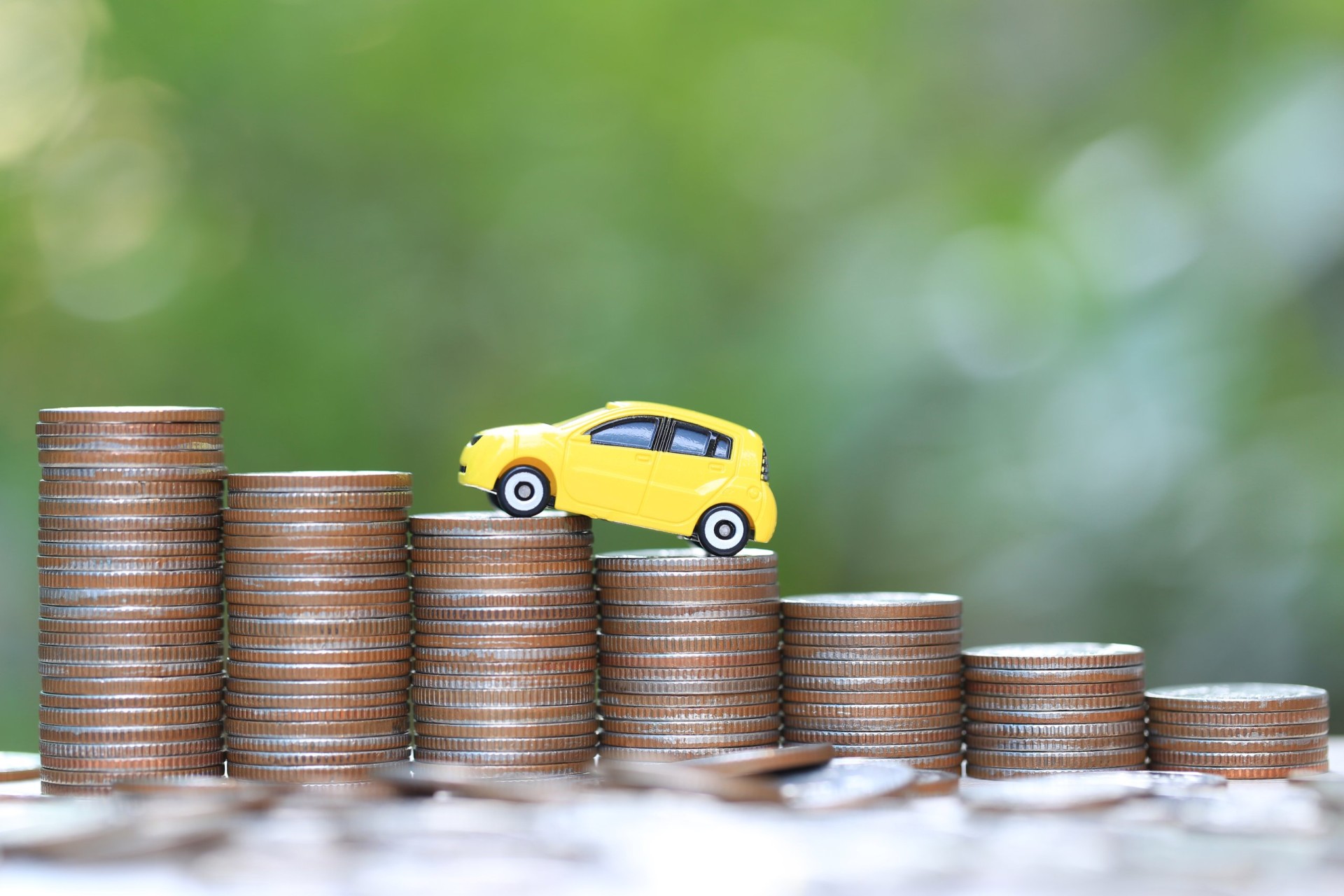
The Jeep brand has long represented adventure and exploration. The automaker has a lineup of off-road-ready vehicles with open-air appeal, and this go-anywhere capability has inspired legions of loyal Jeep drivers. While Jeep continues to make popular vehicles, its reliability scores have lagged behind other car brands. Some Jeep vehicles have lower reliability scores than comparable cars on the market, but despite these concerns, Jeep’s popularity and following may balance its depreciation rate. Besides Jeep’s reputation, here are some other factors that can impact the depreciation rate of your Grand Cherokee.
Age
You probably know a car’s age can affect its resale value. A vehicle’s model year defines its generation. Each year, automakers typically update their vehicles with new features, styling, or technology. In some model years, vehicles undergo complete redesigns. As those new cars hit the market, the outgoing model years tend to depreciate more quickly.
All these updates and changes make some model years better than others. In some cases, newer may not always be better, especially if a new model year has issues related to quality or maintenance. For this reason, your car’s model year can significantly impact its depreciation and resale value.
Body Type
The body type of your vehicle is another factor affecting its depreciation. Body type refers to a vehicle’s size and classification. Some common body types include sedans, coupes, hatchbacks, convertibles, station wagons, sports cars, sport-utility vehicles (SUVs), minivans, and pickup trucks. In the North American market, trucks and SUVs usually have the slowest depreciation rates since there’s a high demand for those vehicles. In contrast, small luxury cars often depreciate at the fastest rate.
The Jeep Grand Cherokee is a full-size SUV. This body type usually depreciates more slowly than sedans, coupes, and other small cars. However, if the market changes and demand becomes higher for compact cars, SUVs such as the Grand Cherokee may start to depreciate faster.
Mileage
How many miles you put on a car can affect its resale value. Typically, high-mileage vehicles show more signs of wear and tear since they’ve had more use. They often require more maintenance or even advanced repairs compared with vehicles of lower mileage.
According to data from the Federal Highway Administration, the average driver puts slightly more than 1,000 miles on their vehicle each month. For this reason, we base our model on 12,000 miles of driving per year. If you drive more than the average, your Grand Cherokee may depreciate more quickly. Similarly, if you drive fewer miles than average each year, you might slow the rate of depreciation.
Overall Condition
When you hear about a vehicle’s overall condition, this means the way it looks and runs. A vehicle in good condition has no major mechanical issues or cosmetic defects. You can keep your Grand Cherokee in good condition by following Jeep’s recommended maintenance schedule. Other ways to maintain its condition include driving safely to avoid accidents and cleaning the SUV to keep it looking its best. If you have a Grand Cherokee in good condition, chances are it will be worth more when you’re ready to sell or trade it.
However, it’s important to note that at some point, it may not be worth spending money to maintain your vehicle. This is true if maintenance or repairs will cost more than what it’s worth. Do your research to ensure you’re not spending money to repair a vehicle that you won’t recover when you sell it.
Color
Even a vehicle’s color can affect its depreciation. According to a study by iSeeCars, certain colors have a higher resale value than others. In particular, yellow, beige, orange, and green have the lowest three-year depreciation rates compared with other colors, according to the study. That data makes sense when you consider that there are fewer bold-colored vehicles on the road.
So what colors experience the fastest depreciation? According to the study, gold, brown, black, and silver are more likely to depreciate at a faster rate, probably because they’re common vehicle colors in today’s market. Knowing this information, you may be able to improve your Grand Cherokee’s resale value by purchasing one in a rarer color.
Other Costs of Jeep Grand Cherokee Ownership
While it’s important to consider a vehicle’s depreciation rate, this is only one part of the total cost of ownership. Here are some other associated costs of owning a Jeep Grand Cherokee.
Insurance
Your insurance premiums can vary based on several factors, including the car you drive. Insurers charge different rates for vehicles based on their safety and use. Typically, cars with more safety features designed for personal use have cheaper insurance rates.
On average, the Jeep Grand Cherokee costs less to insure than other vehicles. Data shows it costs about $127 per month to insure the SUV for an annual cost of $1,524. Nationally, the average cost of car insurance is $1,759 per year. Where you live can also impact the insurance premiums you pay on a Grand Cherokee. For example, it’s one of the cheapest cars to insure in California.
Maintenance
It’s important to perform routine maintenance on your Grand Cherokee to keep it in good condition and maintain its value. On average, it costs $693 per year to maintain a Grand Cherokee. That brings the Grand Cherokee in line with the average maintenance cost of all cars, which is $694 per year. To see the costs for your specific model year, you can take a look at our graph of Jeep Grand Cherokee maintenance costs.
It’s important to know the costs by model year because some years may be more expensive to maintain. In particular, the following Jeep Grand Cherokee model years have known issues, including lower reliability scores and a greater likelihood of mechanical problems:
- 2001-2007
- 2009-2013
The Best Model Year To Buy a Jeep Grand Cherokee
Based on factors including price and reliability (but not depreciation), our choice for the best Jeep Grand Cherokee model years to buy are 2008, and 2014-2021, but check out our article on the best and worst years of the Grand Cherokee to get the whole story. These model years have excellent reliability ratings and a lower chance of needing extensive repairs. Plus, owners of these model years report high satisfaction scores.
Buying a Jeep Grand Cherokee New vs. Used
| 20-Year Projection | ||
| Years Since Purchased | Depreciated Value | With Inflation |
| 1 | $30,284 | $33,432 |
| 2 | $24,314 | $28,412 |
| 3 | $23,958 | $28,143 |
| 4 | $20,598 | $24,286 |
| 5 | $17,672 | $20,736 |
| 6 | $16,961 | $19,852 |
| 7 | $14,035 | $16,453 |
| 8 | $11,149 | $13,146 |
| 9 | $9,172 | $10,852 |
| 10 | $7,670 | $9,172 |
| 11 | $7,433 | $9,035 |
| 12 | $5,930 | $7,412 |
| 13 | $2,767 | $3,520 |
| 14 | $2,412 | $3,100 |
| 15 | $1,779 | $2,252 |
| 16 | $1,384 | $1,735 |
| 17 | $909 | $1,137 |
| 18 | $633 | $796 |
| 19 | $1,028 | $1,286 |
| 20 | $909 | $1,120 |
When buying a Jeep Grand Cherokee, you may wonder if it’s better to go with a new or used vehicle. To beat the highest rates of depreciation, we recommend purchasing a used Grand Cherokee. The total accumulated depreciation for a two-year used Grand Cherokee is $15,361. In comparison, a brand-new Grand Cherokee will depreciate by about $15,577 from its original MSRP in the first three years. By buying a used vehicle, the former driver takes the greatest hit in depreciation, helping you save money throughout your ownership.
It’s important to do your research when purchasing a used vehicle. Use online resources, such as Kelley Blue Book, to determine the worth of the car you’re looking to buy. Take into account other costs of ownership, including insurance and maintenance, to make sure you’re getting a car you can afford.
Methodology
The data in this article applies to the base trim for a Jeep Grand Cherokee with standard equipment and options. If you purchase a higher trim with advanced features, it may have a higher value than that presented here. Other factors can also play a role in resale value and depreciation, including the condition of the vehicle and how you choose to sell it. Some factors, such as the COVID-era chip shortage, depend on the market at the time you’re ready to sell your vehicle.
Keep in mind, there are large economic factors at play here too and the sale of new cars has caused shifts in the used market too. There is a stark difference in the cost of vehicles due to car manufacturers seeking higher profit margins after COVID as detailed by CNN and posted by CBS channel 58:
“… (T)he auto industry saw sky-high profits even as sales plummeted. Domestic manufacturers of cars and car parts saw a profit of $32 billion through the third quarter of 2022 (the latest data available) — their largest profit since 2016. Car dealerships also reported record-breaking profits through Q3, according to auto-retail advisers Haig Partners.
That’s because pandemic-era pent-up consumer demand remained strong as supply shifted, allowing automakers to increase their prices and their profit margins. Cars and trucks were sold nearly as soon as they hit dealership lots, and the average price paid for a vehicle in December soared to a near-record high of $46,382, according to J.D. Power.
Data from the Labor Department’s November Consumer Price Index shows American consumers are paying about 20% more for cars than they were in 2019.
The trend could continue into next year — research website Edmunds expects new-car sales to hit 14.8 million in 2023, a marginal increase from last year but well below pre-pandemic levels.
The auto industry has entered a new era: Less choice, higher price,es and larger profit margins. So far it seems to be working for them.”
This shift by car companies to create higher profit margins by taking advantage of the heavily-reported-on chip shortage panic of COVID has had rebounding effects upon the value of used cars.
Be aware that newer years (the latest 3-4 model years) may be inflated in price because of this and depending on how big this problem is for the model you are considering – it may even be inflating the price of the older model years.
Frequently Asked Questions About Vehicle Depreciation
Do Jeep Grand Cherokees hold their value?
In general, Jeep Grand Cherokees don’t hold their value particularly well. However, the price you get for your Grand Cherokee can depend on various factors, including age, mileage, and condition. In addition, how and where you sell your Grand Cherokee can determine its value.
For example, if you have a 2021 black Jeep Grand Cherokee Laredo E in good condition, you can get $24,304 if you trade it into a dealership, according to Kelley Blue Book data. The same vehicle is worth $27,588 if you sell it privately.
What are the best years of Jeep Grand Cherokee to buy and which ones should you avoid?
Purchasing the right model year can help you get the highest resale value for your Grand Cherokee. The following model years are the best to purchase based on factors such as reliability ratings, safety scores, low costs of ownership, and a minimal chance of repairs:
- 2008
- 2014-2016
- 2017-2020
- 2021
In contrast, there are some model years of the Grand Cherokee that you should avoid. Here are the model years we don’t recommend purchasing based on factors including lower reliability scores, a higher cost of ownership, and significant mechanical problems:
- 2001-2004
- 2005-2007
- 2009-2010
- 2011-2013
What's high mileage for a Jeep Grand Cherokee?
There are varying degrees of how well the Grand Cherokee is cared for and treated, and it all depends on the previous owners. Maintenance will be the most important factor, especially if you want the SUV to last more than 175,000 miles. Based on our data, a high-mileage Jeep Grand Cherokee could be considered anything over 135,000 miles.
Older Jeep Grand Cherokee models (2001-2010) show an average mileage range between 130,000 and 184,000. The 2006 has the highest mileage in our surveys, but there are plenty that get close to 175,000 miles. As the mileage increases on Grand Cherokee models, the resale value naturally decreases. Once the Jeep has a lower resale value, it won’t be worth fixing expensive problems.
How old of a Jeep Grand Cherokee should you buy to avoid most of the depreciation?
For the Jeep Grand Cherokee, the depreciation sweet spot lies between the model years 2002-2006. When you purchase one of these model years, you can avoid the highest rate of depreciation. To take full advantage of this sweet spot, don’t buy a Grand Cherokee older than 2002.
References
(2021). Are Jeeps Reliable? We Review the Brand’s History of Reliability. Vehicle History. Retrieved Sept. 20, 2023, from https://www.vehiclehistory.com/articles/are-jeeps-reliable-we-review-the-brands-history-of-reliability
Jeep. Consumer Reports. Retrieved Sept. 20, 2023, from https://www.consumerreports.org/cars/jeep/
(2023). Jeep Grand Cherokee. Jeep. Retrieved Sept. 20, 2023, from https://www.jeep.com/grand-cherokee.html

At FIXD, our mission is to make car ownership as simple, easy, and affordable as possible. Our research team utilizes the latest automotive data and insights to create tools and resources that help drivers get peace of mind and save money over the life of their car.

